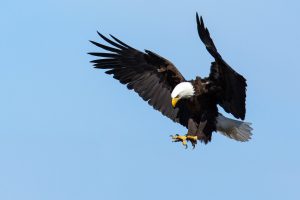Keep a watch high above you as we cruise down the South River for America’s most iconic bird, the Bald Eagle. You might mistake them at first for an osprey or black or turkey vulture, maybe even a raven. But the moment you spot that white head and white tail, there’s absolutely no mistake. It’s a truly exciting moment!
Along the towering shoreline pines of the Chesapeake Bay, where ancient oaks and loblolly pines pierce the sky, bald eagles have made a remarkable comeback.

Bald eagles, with their unmistakable white heads gleaming like beacons against dark bodies, have reclaimed their throne as the Bay’s apex aerial predators, creating a wildlife viewing spectacle that draws visitors from across the country.
These massive birds make even the impressive osprey look modest by comparison. With wingspans stretching to seven and a half feet, adult eagles command attention whether perched regally on a dead snag or soaring high above the Bay’s waters. Their size advantage often leads to aerial displays of dominance – eagles are notorious for harassing ospreys until they drop their fresh-caught fish, an aerobatic chase that ends with the eagle swooping down to snatch the abandoned meal from mid-air. That doesn’t mean they don’t get chased away by ospreys protecting their territory though. These birds are fierce competitors.
Perhaps nothing speaks to the eagles’ commanding presence quite like their nests. There’s one on the Rhode River. High in the Bay’s largest trees, eagle pairs construct massive nurseries that can weigh up to a ton. These architectural marvels, built stick by careful stick, grow larger each year as the committed pair returns to add new materials. Some nests reach eight feet across and can be six feet deep – essentially creating an apartment complex in the sky that can last for decades – if the tree holds.
The seasonal rhythms of the Bay bring dramatic changes to our eagle population. While some pairs remain year-round, maintaining their massive nests through all seasons, many eagles from the Mid-Atlantic region migrate south for winter. But as these residents depart, northern eagles from New England and Canada arrive, drawn by the Bay’s relatively ice-free waters and abundant food. This winter influx can create spectacular congregations around productive fishing grounds, where multiple eagles may be seen sharing the same stretch of shoreline.
Watching an eagle fish is to witness power and precision in perfect balance. Unlike the dramatic straight-down plunge of their osprey neighbors, eagles employ a more horizontal approach, skimming low over the water with their massive talons extended. At the last second, they brake with their wings and reach deep, often emerging with fish that would seem too large for most birds to lift.
The dedication to their nesting territories reveals another fascinating aspect of eagle behavior. Despite their fierce independence for most of the year, mated pairs maintain strong bonds to both each other and their nesting territory. When spring calls the migrants back, they return to the same nesting sites, refurbishing their massive structures with fresh pine boughs, grasses, and even bits of shoreline debris. The nest cup itself is lined with their own down feathers, creating a soft cradle for their eggs and chicks.

Dawn and dusk offer prime eagle-watching opportunities, as these early risers and late hunters patrol their territories in the quiet hours. Look for them perched on prominent dead trees overlooking the water, their white heads visible from surprising distances. During midday, they often soar on thermal currents, sometimes in pairs, wheeling and diving in spectacular courtship displays that showcase their aerial mastery.
What makes these sightings even more special is the knowledge that just a few decades ago, such encounters were rare. The eagles’ recovery in the Chesapeake region stands as one of America’s great conservation success stories. Today, their presence reminds us of nature’s resilience when given the chance to recover.
So on your next Bay charter, scan the Bay’s waters for these magnificent birds in action. Whether you witness an adult eagle teaching its dark-headed youngster to fish, or see one challenge an osprey for its catch, you’re observing more than just a bird – you’re watching a living symbol of wild America thriving once again on the Chesapeake’s nurturing waters.
